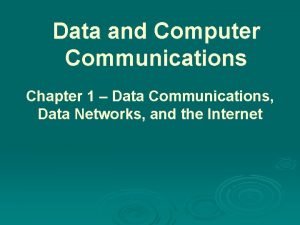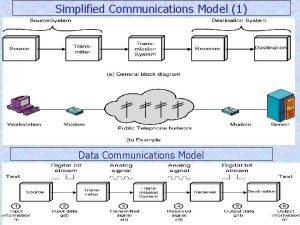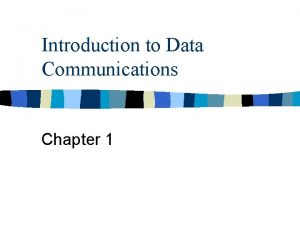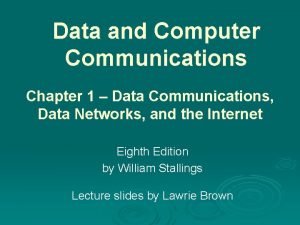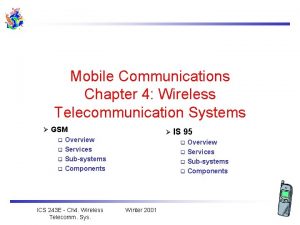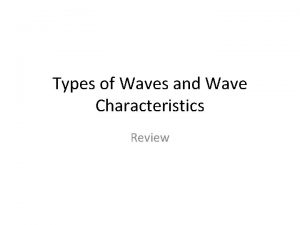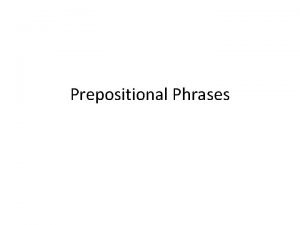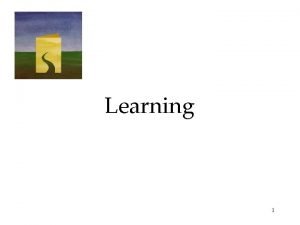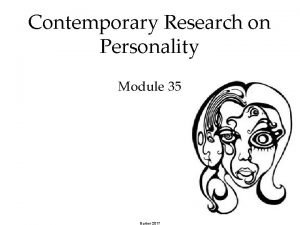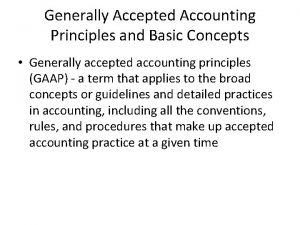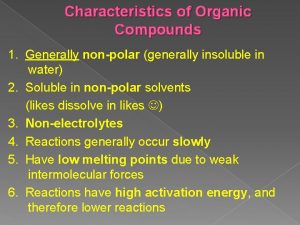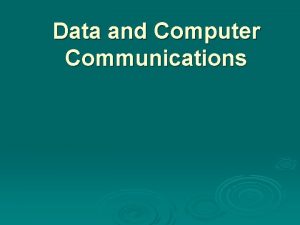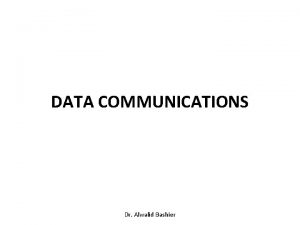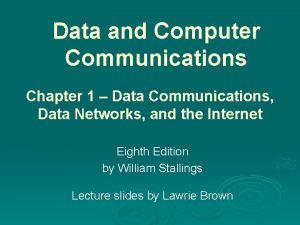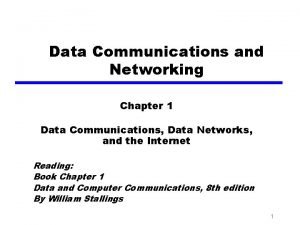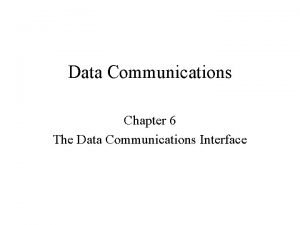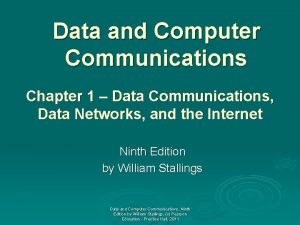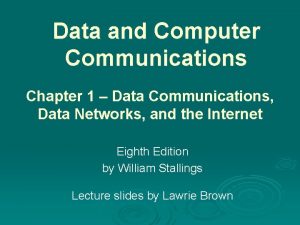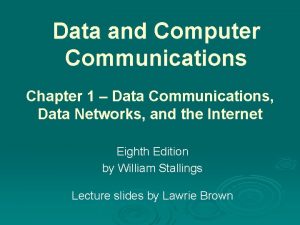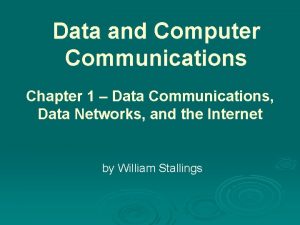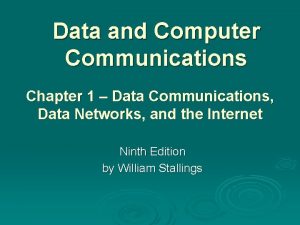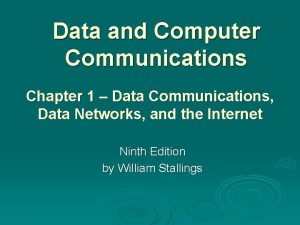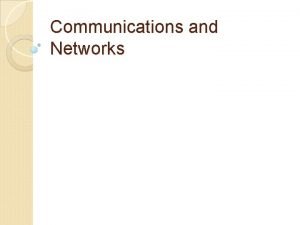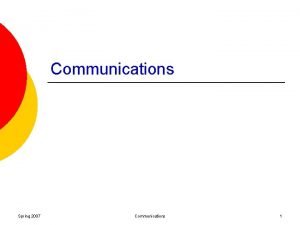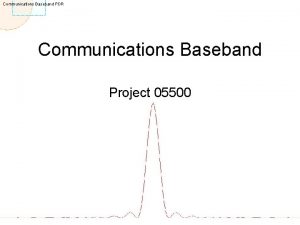Chapter 2 Data Communications n n n Generally


























- Slides: 26

Chapter 2 : Data Communications n n n Generally, data usable to a person or application are not in a form that can be transmitted over a network. To be transmitted, data must be transformed to electromagnetic signals All form of information – can be represented by electromagnetic signals q Voice, data, image, video etc BENG 4522 Data Communications & Computer Networks Chapter 2 : Data Communications 1

2. 1 Analog & Digital n n Data can be analog or digital Analog data q q n Digital data q q n Refers to information that has discrete states – data stored in computer memory (0 and 1) take discrete values. Analog signal q n Refers to information that is continuous – sound made by human voice Take on continuous values have an infinite number of values in a range Digital signal q Digital signal – have only a limited number of defined values (i. e. 0 or 1) BENG 4522 Data Communications & Computer Networks Chapter 2 : Data Communications 2

2. 1 Analog & Digital BENG 4522 Data Communications & Computer Networks Chapter 2 : Data Communications 3

2. 2 Periodic & Nonperiodic signal n Periodic signal q n Nonperiodic signal q n the signal changes without exhibiting a pattern/cycle that repeats over time Both analog and digital signals can be periodic or nonperiodic q n The signal completes a pattern within a measurable time frame/period, and repeats that pattern over subsequent identical periods. Refers to information that is continuous – sound made by human voice In data communications, we commonly used periodic analog signals and nonperiodic digital signals BENG 4522 Data Communications & Computer Networks Chapter 2 : Data Communications 4

2. 2 Periodic & Nonperiodic signal n Periodic analog signals q Periodic analog signals can be classified as n n n Simple – sine wave (cannot be decomposed into simpler signals) Composite – composed of multiples sine waves Sine wave q Sine wave can be represented by 3 parameters – peak amplitude, frequency and the phase BENG 4522 Data Communications & Computer Networks Chapter 2 : Data Communications 5

2. 2 Periodic & Nonperiodic signal n Period and frequency q q Period – refers to the amount of time, in seconds, a signals need to complete 1 cycle. Frequency – refer to the number of periods in 1 s. BENG 4522 Data Communications & Computer Networks Chapter 2 : Data Communications 6

2. 2 Periodic & Nonperiodic signal n Period and frequency BENG 4522 Data Communications & Computer Networks Chapter 2 : Data Communications 7

2. 2 Periodic & Nonperiodic signal n Wavelength q q Wavelength describes how far the wave can travel in 1 period time. Depends on the frequency and the medium BENG 4522 Data Communications & Computer Networks Chapter 2 : Data Communications 8

2. 2 Periodic & Nonperiodic signal n Wavelength q q Propagation speed of electromagnetic signals depends on the medium and on the frequency of the signal The relation between the wavelength and frequency of electromagnetic signals travel in vacuum n λ: wavelength, f : frequency, c : speed of light 3 x 108 ms-1 BENG 4522 Data Communications & Computer Networks Chapter 2 : Data Communications 9

2. 2 Periodic & Non-periodic signal n Time and frequency domains q q Time-domain – the waveform is plot in changes of signal amplitude with respect to time. Frequency-domain – plot is concerned only with the peak value and frequency. BENG 4522 Data Communications & Computer Networks Chapter 2 : Data Communications 10

2. 2 Periodic & Non-periodic signal n Time and frequency domain q The time domain and frequency domain of three sine waves. BENG 4522 Data Communications & Computer Networks Chapter 2 : Data Communications 11

2. 2 Periodic & Non-periodic signal n Composite signal q q According to fourier analysis, any composite signal is a combination of simple sine wave with different frequencies, amplitudes and phases. Can be periodic or nonperiodic If the composite signal is periodic, the decomposition gives a series of signal with discrete frequencies (integer value i. e. 1, 2, 3, . . . ). If the signal is nonperiodic, the decomposition gives a combination of sine waves with continuous frequencies (real values). BENG 4522 Data Communications & Computer Networks Chapter 2 : Data Communications 12

2. 2 Periodic & Non-periodic signal n Periodic Composite signal q The component sinusoids are at frequencies that are multiples of the basic frequency of periodicity. harmonics Fundamental frequency BENG 4522 Data Communications & Computer Networks Chapter 2 : Data Communications 13

2. 2 Periodic & Non-periodic signal n Periodic composite signal BENG 4522 Data Communications & Computer Networks Chapter 2 : Data Communications 14

2. 2 Periodic & Non-periodic signal n Nonperiodic composite signal BENG 4522 Data Communications & Computer Networks Chapter 2 : Data Communications 15

2. 2 Periodic & Non-periodic signal n Bandwidth q The bandwidth of a composite signal is the difference between the highest and the lowest frequencies contained in that signal. BENG 4522 Data Communications & Computer Networks Chapter 2 : Data Communications 16

2. 3 Digital signal q In general if a signal has L levels, each level needs log 2 L bits ! BENG 4522 Data Communications & Computer Networks Chapter 2 : Data Communications 17

2. 3 Digital signal n Bit Rate q q n Most digital signals are nonperiodic, and thus period and frequency are not appropriate characteristics. For digital signal, in stead of using frequency, bit rate is used. Bit rate is the number of bits sent in 1 s, expressed in bits per second (bps). Examples Bit Length q The bit length is the distance one bit occupies on the transmission medium. Bit length = propagation speed x bit duration BENG 4522 Data Communications & Computer Networks Chapter 2 : Data Communications 18

2. 3 Digital signal n Digital signal as a Composite Analog Signal q q Fourier analysis can be used to decompose a digital signal. If the digital signal is periodic (which is rare in data communications), the decomposed signal has a frequency domain representation with an infinite bandwidth and discrete frequencies. BENG 4522 Data Communications & Computer Networks Chapter 2 : Data Communications 19

2. 3 Digital signal n Digital signal as a Composite Analog Signal q If the digital signal is nonperiodic, the decompose signal still has an infinite bandwidth, but the frequencies are continuous. BENG 4522 Data Communications & Computer Networks Chapter 2 : Data Communications 20

2. 3 Digital signal n Relationship between bit rate and bandwidth q q q Consider the case binary data is encoded into digital signal, and to be transmitted by a transmission medium. Digital signal contains an infinite bandwidth, but a real transmission medium has a finite bandwidth which can limit the data rate that can be carried on the transmission medium. Limited bandwidth creates distortions of the input signal, which makes the task of interpreting the received signal more difficult. The more limited bandwidth, the greater the distortion, and the greater the potential for error by the receiver. The higher the bit rate of a signal is, the greater is its bandwidth. The greater the bandwidth of a transmission system, the higher is the bit rate that can be transmitted. BENG 4522 Data Communications & Computer Networks Chapter 2 : Data Communications 21

2. 3 Digital signal n Relationship between bit rate and bandwidth BENG 4522 Data Communications & Computer Networks Chapter 2 : Data Communications 22

2. 3 Digital signal n Relationship between bit rate and bandwidth BENG 4522 Data Communications & Computer Networks Chapter 2 : Data Communications 23

2. 3 Digital signal n Transmission of Digital Signals q Digital signals can be transmitted using two different approaches : n n n Baseband transmission Broadband transmission (using modulation) Baseband transmission q q q Signal is sent over a channel without changing the digital signal to analog signal. Baseband transmission requires a low-pass channel, a channel with a bandwidth starts from zero. We know that digital signal is a composite analog signal with an infinite bandwidth. For that, baseband transmission of digital signal that preserves the shape of the digital signal is possible only if we have a low-pass channel with an infinite or very wide bandwidth. In baseband transmission, the required bandwidth is proportional to the bit rate; if we need to send the bits faster, we need more bandwidth. BENG 4522 Data Communications & Computer Networks Chapter 2 : Data Communications 24

2. 3 Digital signal n Broadband transmission (using modulation) q q The digital signal is sent over a channel by changing the digital signal to analog signal (using the modulation process). Modulation allows the use of bandpass channel – a channel with a bandwidth that does not start from zero. BENG 4522 Data Communications & Computer Networks Chapter 2 : Data Communications 25

2. 3 Digital signal n Modulation of a digital signal for a transmission over a passband channel BENG 4522 Data Communications & Computer Networks Chapter 2 : Data Communications 26
 Telecommunications and data communications
Telecommunications and data communications Data and computer communications 10th edition
Data and computer communications 10th edition Data & computer communications
Data & computer communications Backbone network components
Backbone network components Business data communication and networking
Business data communication and networking Simplified communications model
Simplified communications model Introduction to data communications
Introduction to data communications Data and computer communications
Data and computer communications Introduction to data communications and networking
Introduction to data communications and networking William stallings data and computer communications
William stallings data and computer communications Business data communications and networking
Business data communications and networking A fire department communication center functions
A fire department communication center functions Chapter 4 communications and documentation quiz
Chapter 4 communications and documentation quiz Communications chapter
Communications chapter Chapter 3 network protocols and communications
Chapter 3 network protocols and communications Brainpop humidity
Brainpop humidity Sound waves from a radio generally travel in which medium?
Sound waves from a radio generally travel in which medium? Prep phrases
Prep phrases In a minimum cardinality, minimums are generally stated as
In a minimum cardinality, minimums are generally stated as Learning is generally defined as relatively
Learning is generally defined as relatively John is generally pleasant
John is generally pleasant When to use comma before because
When to use comma before because The chaparral biome is best characterized by _______.
The chaparral biome is best characterized by _______. In block format, all new paragraphs are indented
In block format, all new paragraphs are indented An access matrix is generally dense.
An access matrix is generally dense. When securing a cape as draping for a basic shampoo
When securing a cape as draping for a basic shampoo What are finance companies
What are finance companies


